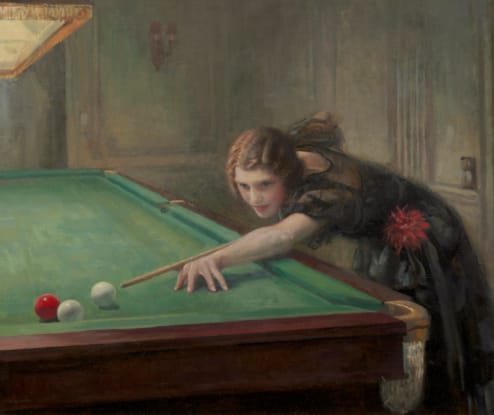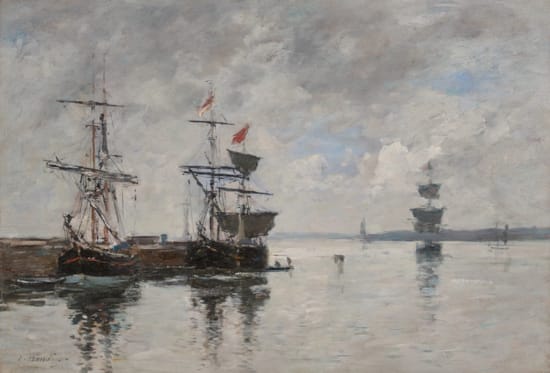Sir Alfred James Munnings, KCVO, PPRA
(1878 - 1959)
The Belvoir Hunt
Signed, lower right: A. J. MUNNINGS
Oil on canvas
18½ x 24½ in – 47 x 62.2 cm
Frame size
22¾ x 28¾ in – 57.8 x 73 cm
Oil on canvas
18½ x 24½ in – 47 x 62.2 cm
Frame size
22¾ x 28¾ in – 57.8 x 73 cm
Height 0¹/₄ in (61.6 cm)
width 6¹/₄ in (76.8 cm)
width 6¹/₄ in (76.8 cm)
Tel.: +44 (0)20 7839 7693
Provenance
Colonel J. A. Innes, DSO;
Anonymous sale, Sotheby’s, London, 12 November 1986, lot 103;
Private collection, UK
Anonymous sale, Sotheby’s, London, 12 November 1986, lot 103;
Private collection, UK
‘Mr A.J. Munnings’ Pictures at the Alpine Gallery’, "Country Life", London, 30 April 1921, p.517 (illustrated);
A.J. Munnings, The Second Burst, London, 1950, pp..68-78
A.J. Munnings, The Second Burst, London, 1950, pp..68-78
London, The Alpine Club Gallery, Pictures of the Belvoir Hunt and other Scenes of English Life, 1921, no.32, as In the Belvoir Woods;
Suffolk, Bury St. Edmunds Art Gallery, A Loan Exhibition of Pictures by Alfred Munnings, 1930, no.10
Suffolk, Bury St. Edmunds Art Gallery, A Loan Exhibition of Pictures by Alfred Munnings, 1930, no.10
Munnings was approached in 1920 by Major Tommy Bouch, Master of the Belvoir hunt, to paint a series of works depicting the Duke of Rutland’s hounds. Having visited the War Records Exhibition at the Royal Academy in 1919, Bouch was struck by the quality of Munnings’ depictions of the Canadian Cavalry. He was keen to accommodate Munnings personally - “… you can stay with me as long as you please … you can make Woolsthorpe your home” – as well as professionally, “… you shall have all the models you need – horses, hounds, men – all day and every day.” (Sir Alfred Munnings, The Second Burst, London, 1950). The major body of work that resulted was exhibited at The Alpine Gallery in 1921; ‘Pictures of the Belvoir Hunt and other Scenes of English Country Life’ (the present work was exhibition number 32 'In the Belvoir Woods') was both a critical and commercial success, further enhancing Munnings’ growing reputation. In the present work the rapid, trotting movement of the hounds is brilliantly rendered with deft, suggestive, yet thinly-applied brushstrokes. In contrast, the horse and huntsman have a greater definition and finish, which imbues them with a stately progress and makes them the clear focal point of the picture, while purple, blue and grey create a beautifully observed and atmospheric winter landscape.
Biography
Sir Alfred J. Munnings was an artist of the twentieth century steeped in the traditions and values of the past. His artistic training was not dissimilar to that of a seventeenth century Master. Showing some early talent, Munnings was apprenticed to a firm of lithographers, Page Brothers in Norwich for six years, studying at Norwich School of Art in the evening.
He had some success locally and showed two paintings at the Royal Academy in 1899. In the same year he returned to set up his studio in Mendham, and in an accident lost the sight in one eye. In his early years he supplemented his income by designing posters at which, with is consummate draughtsmanship he excelled. He studied briefly in Paris between 1902 and 1903.
Munnings drew his subject matter from the East Anglian landscape and rural society. A horse fair of 1901 showed an early interest in horses while fairgrounds and rural occupations provided the artist with considerable subject matter. 1910 saw Munnings visit Lamorna in Cornwall where he met Laura (1877-1970) and Harold Knight (1874-1961), lifelong friends, and where he stayed between 1911 and 1916. In 1913 he held his first one-man show at the Leicester Galleries, where Laura Knight, DBE, RA showed.
In 1918 Munnings was appointed as a war artist with the Canadian Cavalry Brigade, producing an important body of work for the Canadian Government. Munnings settled in Dedham in 1918, marrying Violet in 1920. He was elected Royal Academician in 1925, to the RWS in 1929, in 1944 Munnings was knighted and elected President of the Royal Academy between 1944 and 1949. In this latter role he famously made known his utter contempt for ‘Modern Art’. Munnings was a prolific artist and a consummate draughtsman, whose work as a war artist raised his profile and reputation. Best known for his equestrian works, portraits and racing works, Munnings range was enormous. He excelled in landscape and scenes of rural life, recording a way of life that was coming to an end.
His works are in the collections of HM the Queen, J. Mitchell Chapman, Lord Fairhaven and Major Sir Reginald Macdonald Buchanan. His works can be found in museums in: Birmingham; Liverpool; London, Tate Gallery; Norwich; Preston; USA, Yale University; Brisbane and Melbourne.
He had some success locally and showed two paintings at the Royal Academy in 1899. In the same year he returned to set up his studio in Mendham, and in an accident lost the sight in one eye. In his early years he supplemented his income by designing posters at which, with is consummate draughtsmanship he excelled. He studied briefly in Paris between 1902 and 1903.
Munnings drew his subject matter from the East Anglian landscape and rural society. A horse fair of 1901 showed an early interest in horses while fairgrounds and rural occupations provided the artist with considerable subject matter. 1910 saw Munnings visit Lamorna in Cornwall where he met Laura (1877-1970) and Harold Knight (1874-1961), lifelong friends, and where he stayed between 1911 and 1916. In 1913 he held his first one-man show at the Leicester Galleries, where Laura Knight, DBE, RA showed.
In 1918 Munnings was appointed as a war artist with the Canadian Cavalry Brigade, producing an important body of work for the Canadian Government. Munnings settled in Dedham in 1918, marrying Violet in 1920. He was elected Royal Academician in 1925, to the RWS in 1929, in 1944 Munnings was knighted and elected President of the Royal Academy between 1944 and 1949. In this latter role he famously made known his utter contempt for ‘Modern Art’. Munnings was a prolific artist and a consummate draughtsman, whose work as a war artist raised his profile and reputation. Best known for his equestrian works, portraits and racing works, Munnings range was enormous. He excelled in landscape and scenes of rural life, recording a way of life that was coming to an end.
His works are in the collections of HM the Queen, J. Mitchell Chapman, Lord Fairhaven and Major Sir Reginald Macdonald Buchanan. His works can be found in museums in: Birmingham; Liverpool; London, Tate Gallery; Norwich; Preston; USA, Yale University; Brisbane and Melbourne.



_1322024T15532.958.jpg?width=550&height=415&format=jpg&quality=80&mode=max)
